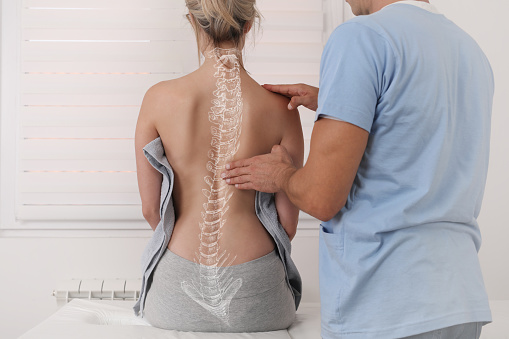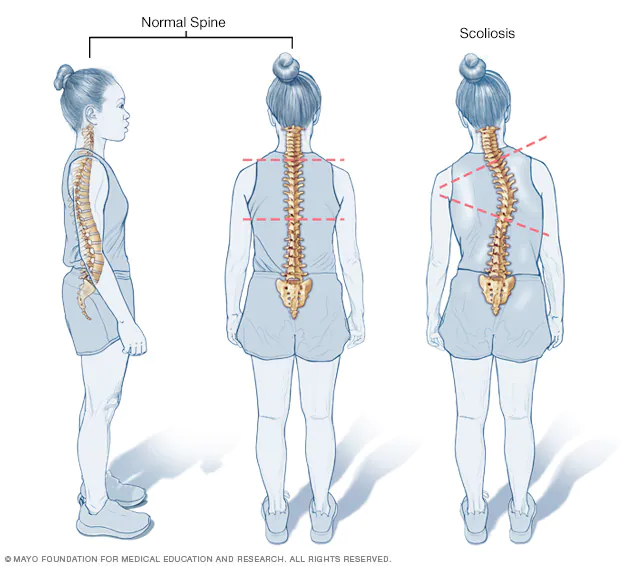Scoliosis
 pixabay
pixabay
I have seen so many cases of scoliosis, and in Nigeria, it is quite common, about a million cases per year.
Scoliosis is a sideways curve of the spine. It is pathologic and abnormal. The spine has its curves, but none are sideways.
 WebMD
WebMD
But this case, this case got me worried. The index patient is a woman in her 50s, presented to the orthopedics clinic with complaints of severe pain, which worsens on standing. The maximum time she can spend standing is 15 minutes.
Now, when she was asked how it started, you will not believe what she had to say. She used a wheelbarrow to move a truckload of sand! Only her, no assistance, moved a truckload of sand! Because she didn't have the money to employ labourers.
Now, she came with an x-ray film, which showed a typical picture of scoliosis, but the consultant needed better imaging to get a clearer picture, so requested an MRI. She inquired on the price, when she was told, she just said she couldn't afford it.
This is just another case of poverty resulting in sickness. This will not be the last time such would happen, many people would do extremely hard labour to put food on the table, and on the long run, will not be able to enjoy their older days. And sad truth is, she'd have spent less employing labourers than paying for her MRI.
Now, she can't pay for her MRI nor her treatment. She's gonna have to live with scoliosis and most probably, a life long pain medication. Now, let's find out what this woman is going to have to face for the rest of her life.
It should be noted that most cases of scoliosis are idiopathic, that means their causes are unknown. Majority of cases are usually identified in adolescence.
Classifying scoliosis based on age, our index patient is what we describe as the adult type as it occurred past the age of 18. The other types are infantile(3 years and below), juvenile(4 to 10 years) and adolescent(11 to 18).
A more descriptive classification is based on aetiology, that means the cause. Idiopathic scoliosis comprises about 80% of cases.
Congenital scoliosis, which is as a result of developmental malformations. Neuromuscular scoliosis, as seen in conditions such as spina bifida and cerebral palsy. Degenerative scoliosis, seen typically in adults as a result of aging and wearing out of the backbone. This is the class the index patient falls into.
The cause in her case is known and its as a result of the stress and trauma to the backbone as a result of the unreasonable amount of load she carried. Other common causes of scoliosis include birth defects, neurological diseases and genetic disorders.
Another classification of scoliosis is into nonstructural and structural scoliosis. Nonstructural scoliosis is as a result of an identifiable cause and usually reverts after treatment of cause.
Examples of such causes include appendicitis, muscle spasms or if one leg is longer than the other. Structural scoliosis, here the spine is rigid and most likely irreversible.
The presenting complaints in scoliosis are usually structural anomalies and pain. Structural anomalies may include uneven shoulder blades, unequal shoulders, uneven waist, a hip higher than the other, a half leaning more forward than the other.
Pain of varying degrees, as seen in the index patient. She initially could stand for more than 30 minutes, then the pain kept progressing and now, she can barely stand for 15 minutes. Other features are a visible curve at the back, back stiffness and fatigue.
Diagnosis of scoliosis is clinical by physical examination and imaging investigations. Imaging techniques employed are x-ray, MRI, CT scan and bone scan.
The treatment options vary depending on age and degree of curvature. The go-to treatment options are bracing and surgery.
A brace is preferred if the patient is still growing and the curvature ranges from 25° to 40°. Braces will not correct the curve but will prevent further curving. This treatment modality is preferred in early cases. Patients are advised to use the brace for 16 to 23 hours daily until the stop growing for better outcome. I know, sounds like a lot of stress.
Surgery is the preferred treatment modality for curves greater than 40°. The procedure is called spinal fusion and a rod and some screws are used to keep the spine in place. The rods are adjustable, so as the child grows, adjustments can be made.
This is also the treatment modality of choice in the index patient as she is done growing. But due to financial constraints, the patient only got palliative care as she was given pain killers.
The prognosis in scoliosis is dependent on the degree of curve. Mild to moderate curves have considerably good prognosis. Exercises, such as stretching, have been shown to be beneficial in straightening the spine, but ofcourse, that is only applicable in mild go moderate cases.
Complications associated with scoliosis are difficulty breathing, back problems, mainly the chronic pain limiting one's activity and appearance insecurity as scoliosis worsens, uneven hips and shoulders could alter the figure of the patient and have them insecure.
 WebMD
WebMDBut this case, this case got me worried. The index patient is a woman in her 50s, presented to the orthopedics clinic with complaints of severe pain, which worsens on standing. The maximum time she can spend standing is 15 minutes.
Now, when she was asked how it started, you will not believe what she had to say. She used a wheelbarrow to move a truckload of sand! Only her, no assistance, moved a truckload of sand! Because she didn't have the money to employ labourers.
Now, she came with an x-ray film, which showed a typical picture of scoliosis, but the consultant needed better imaging to get a clearer picture, so requested an MRI. She inquired on the price, when she was told, she just said she couldn't afford it.
This is just another case of poverty resulting in sickness. This will not be the last time such would happen, many people would do extremely hard labour to put food on the table, and on the long run, will not be able to enjoy their older days. And sad truth is, she'd have spent less employing labourers than paying for her MRI.
Now, she can't pay for her MRI nor her treatment. She's gonna have to live with scoliosis and most probably, a life long pain medication. Now, let's find out what this woman is going to have to face for the rest of her life.
It should be noted that most cases of scoliosis are idiopathic, that means their causes are unknown. Majority of cases are usually identified in adolescence.
Classifying scoliosis based on age, our index patient is what we describe as the adult type as it occurred past the age of 18. The other types are infantile(3 years and below), juvenile(4 to 10 years) and adolescent(11 to 18).
A more descriptive classification is based on aetiology, that means the cause. Idiopathic scoliosis comprises about 80% of cases.
Congenital scoliosis, which is as a result of developmental malformations. Neuromuscular scoliosis, as seen in conditions such as spina bifida and cerebral palsy. Degenerative scoliosis, seen typically in adults as a result of aging and wearing out of the backbone. This is the class the index patient falls into.
The cause in her case is known and its as a result of the stress and trauma to the backbone as a result of the unreasonable amount of load she carried. Other common causes of scoliosis include birth defects, neurological diseases and genetic disorders.
Another classification of scoliosis is into nonstructural and structural scoliosis. Nonstructural scoliosis is as a result of an identifiable cause and usually reverts after treatment of cause.
Examples of such causes include appendicitis, muscle spasms or if one leg is longer than the other. Structural scoliosis, here the spine is rigid and most likely irreversible.
The presenting complaints in scoliosis are usually structural anomalies and pain. Structural anomalies may include uneven shoulder blades, unequal shoulders, uneven waist, a hip higher than the other, a half leaning more forward than the other.
Pain of varying degrees, as seen in the index patient. She initially could stand for more than 30 minutes, then the pain kept progressing and now, she can barely stand for 15 minutes. Other features are a visible curve at the back, back stiffness and fatigue.
Diagnosis of scoliosis is clinical by physical examination and imaging investigations. Imaging techniques employed are x-ray, MRI, CT scan and bone scan.
The treatment options vary depending on age and degree of curvature. The go-to treatment options are bracing and surgery.
A brace is preferred if the patient is still growing and the curvature ranges from 25° to 40°. Braces will not correct the curve but will prevent further curving. This treatment modality is preferred in early cases. Patients are advised to use the brace for 16 to 23 hours daily until the stop growing for better outcome. I know, sounds like a lot of stress.
Surgery is the preferred treatment modality for curves greater than 40°. The procedure is called spinal fusion and a rod and some screws are used to keep the spine in place. The rods are adjustable, so as the child grows, adjustments can be made.
This is also the treatment modality of choice in the index patient as she is done growing. But due to financial constraints, the patient only got palliative care as she was given pain killers.
The prognosis in scoliosis is dependent on the degree of curve. Mild to moderate curves have considerably good prognosis. Exercises, such as stretching, have been shown to be beneficial in straightening the spine, but ofcourse, that is only applicable in mild go moderate cases.
Complications associated with scoliosis are difficulty breathing, back problems, mainly the chronic pain limiting one's activity and appearance insecurity as scoliosis worsens, uneven hips and shoulders could alter the figure of the patient and have them insecure.
Referencing
https://www.mayoclinic.org/diseases-conditions/scoliosis/symptoms-causes/syc-20350716
0
0
0.000
I upvoted you, thank you for posting! 👍
Thanks for your contribution to the STEMsocial community. Feel free to join us on discord to get to know the rest of us!
Please consider supporting our funding proposal, approving our witness (@stem.witness) or delegating to the @stemsocial account (for some ROI).
Please consider using the STEMsocial app app and including @stemsocial as a beneficiary to get a stronger support.
Congratulations @topdollar001! You have completed the following achievement on the Hive blockchain and have been rewarded with new badge(s) :
Your next target is to reach 3000 upvotes.
You can view your badges on your board and compare yourself to others in the Ranking
If you no longer want to receive notifications, reply to this comment with the word
STOP